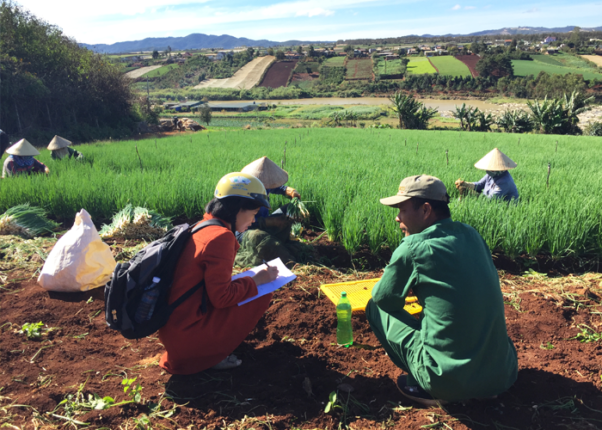
Women play a vital role in agriculture, especially in developing countries, but because technologies, practices and training are mainly designed by and delivered to men, they are less effective at enabling women to achieve their productive potential. Research and development professionals are working to overcome such gender biases, but they aren’t always sure how to best go about it, especially when it comes to technical issues.
“Technologies to control pests and diseases are primarily developed from scientific perspectives, without considering farmers’ behaviors and capacities, which vary with social, gender and economic contexts,” observes Nozomi Kawarazuka, a social anthropologist with the International Potato Center (CIP).
Kawarazuka notes that pests and diseases cause 20 to 40 percent of crop loss globally, most of it in developing countries, so improving their management by small scale farmers could significantly improve food security and incomes. She participated in a multidisciplinary group of CGIAR scientists who studied gender and cultural differences in how farmers deal with pests and diseases and came up with a list of frequently asked questions and responses to help researchers and extension agents take such issues into account. They compiled that information in a brief that provides advice in areas such as designing research questions, overcoming common challenges and facilitating women’s participation.
“We developed the brief to help extension workers and researchers get a better idea of the diversity and differences that exist among farmers,” says Kawarazuka.
That brief has been translated into six languages and shared with government agencies, development organizations and cooperatives in Africa, Central and South East Asia. In East Africa, for example, it was translated into Luganda and Swahili to facilitate use by local government agencies and organizations. It has also been translated into Spanish, French, Georgian and Vietnamese.
Global reach, common challenges
“This valuable brief was a starting point for me to make extension work more gender responsive,” says Pham Thi Hoa, a scientist with the Crop Production and Plant Protection Sub-Department in Lam Dong province, Viet Nam. She explains that the information in it helped her design research questionnaires for a project called Understanding the Adaptation Strategies of Vegetable and Flower Growers in the Time of COVID-19: Case Studies in the Central Highlands of Viet Nam.

Pham explains that she found women farmers were sometimes unable to implement crop protection recommendations because they needed to get approval from their husbands, or were so busy with childcare and housework that the crop protection activities became a burden.
“I am now more conscious of those gender issues and I listen to women farmers’ voices more than I did before. I’m also better at communicating with both men and women farmers,” Pham says.
According to Rusudan Mdivani, CIP Regional Leader for Central Asia and the Caucuses, 150 copies of the Georgian translation of the brief were sent to Georgia’s Potato Producers Network cooperative, as part of the USAID Georgia Potato Program. Mdivani explains that the Potato Program has prioritized getting women, youth and members of the country’s ethnic minorities to participate in trainings, so they can benefit from the innovations it promotes. She notes that this has paid off, citing the example that 10 more women have joined the Potato Producers Network.
“The problem is that women don’t have as much information as men regarding new technologies and measures for protecting potato from different diseases,” observes Ina Girard, a gender specialist working in the Georgia Potato Program. She explains that in some parts of Georgia, women had to ask their husbands for permission to attend the Program’s trainings, and some husbands said no.
“In order for women to realize their potential, it is important that they have support from men,” she says.
Nestan Vibliani, a farmer and cooperative member in Tsalka, Georgia who has participated in several trainings, and encourages other women to do the same, agrees with Girard.
“Our community can benefit from women’s improved knowledge and skills in potato production, and as we gain more knowledge and experience, more women will become involved in potato farming,” Vibliani says.

According to Kawarazuka, the brief is one of many tools and resources available on the Gender-Responsive Agricultural Research for Development portal. She adds that she hopes the brief will be translated into more Asian languages and used in the Women as IPM Leaders Program, which aims to promote integrated pest and disease management among women across Southeast Asia.
“This is a first step to move beyond a top-down, uniform approach to introducing technologies towards establishing a feedback system to keep improving and adjusting technologies according to farmers’ different needs and interest,” Kawarazuka says.
The brief Considering gender in pest and disease management was developed with support from the CGIAR Research Program on Roots Tubers and Bananas.
Blog by David Dudenhoefer
